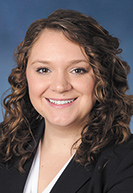Subscriber Benefit
As a subscriber you can listen to articles at work, in the car, or while you work out. Subscribe Now Shives
ShivesJenna Shives and Ryan Leagre
Technology can be a boon for your writing if you know how to use it, but knowing how to use it is key. In an ill-fated attempt to sound smart when writing a recommendation letter, Joey Tribbiani used a newly discovered electronic thesaurus on every single word he had written. “Friends: The One Where Rachel’s Sister Babysits,” (NBC television broadcast Oct. 30, 2003). His original sentence, “They are warm, nice people with big hearts,” became: “They are humid, prepossessing Homo sapiens with full-sized aortic pumps.” It raised a few eyebrows on the television show and did not elicit the response he was expecting. Fortunately, technology has come a long way in the last 15 years. Today’s built-in and add-on programs may help improve your writing without the obvious use of assistive software. The end result may just be a more persuasive, clear, and concise written product.
 Leagre
LeagreBefore you even start writing, using “distraction blocking” software can help boost productivity and increase focus. These programs and apps vary in methods. For instance, one app will allow a user to lock himself out of his smartphone (but still receive calls or allow access to a set list of programs), while another is an internet browser add-on to prevent a user from visiting any websites other than those on her pre-set “whitelist.” Other programs encourage users to focus on a task for a set time period, take a small pre-determined break and repeat (this is known as the Pomodoro Technique). A simple web search for “distraction blocker software” will help you determine what might be best for your use.
Microsoft Word has many great tools that can help structure your writing. Because different versions of Word have different ways to set up the features we’re discussing, visit https://support.office.com/en-us/word for additional help. Word’s templates are a great first step in drafting any document. Litigators and transactional attorneys alike may find that the initial time spent setting up templates for commonly used documents (such as complaints, routine agreements or appellate briefs) are well worth the effort. Using a template does not necessarily mean simply recycling work done on another case. Instead, templates can help you visualize each element in that specific document that must be included so you know you’re not leaving out anything. Templates also can be useful to keep your writing organized and formatted for the specific court in which you are practicing. (Another great benefit of templates is you won’t accidentally copy over metadata from your original document into the new one.) If templates don’t generally suit your practice needs, Microsoft Word’s styles could become invaluable. Users may customize automatic numbering, automatic indenting and automatic formatting such as underlines, italics and bolds based on the indent level. Certainly, you can do all of this manually, but using a style will ensure consistency across the document.
Once you’ve finished drafting and are on to the editing and revising stage, Word has a built-in spelling and grammar check, but did you know it also allows you to see readability statistics of your document? The readability statistics tell you average statistics of sentences per paragraph, words per sentence, and characters per word. It also gives a readability score based on the Flesch Reading Ease (the higher the score, the more readable the document) and Flesch-Kincaid Grade Level. These can be especially helpful in evaluating the readability of expert reports or technical arguments.
Perhaps one of the most underappreciated editing tools in Word is the speak tool. It becomes so easy to skim over text you have already written and for your brain to accidentally a word when editing (see what we did there?). Instead of reading the text to yourself, you can have Word perform this task for you. Simply highlight the text you’d like Word to speak, press “speak,” and listen as the inflectionless voice reads your text back to you. If you are not persuaded by a neutral-tone voice, will you reader be persuaded?
Take an hour or so to look around Word to figure out how it can help you improve your writing and editing efficiency. Did you know Word can mark stylistic preferences for you, such as flagging a missing Oxford comma at the end of the series? Word also can be set to detect when there is a number other than one (or two) spaces after the end of a sentence.
Tools to help your writing are not limited to what’s in Word. Instead of having to go around to your co-workers asking for a particular word that you can’t quite come up with, try using an online “reverse dictionary” such as www.onelook.com. This site lets you enter a definition of a word or phrase and will provide relevant words that have a similar definition. The website gives an example of a search for “being tried twice for the same crime.” The top three results are double jeopardy, repetition, and repeater. Each result word gives you its definition when you click on it so you can ensure the word you are using is actually the word you want.
Grammarly.com is another great resource to use in editing. This free website will evaluate your text for grammar, punctuation and, with a paid premium account, makes suggestions to improve word choice and wordiness. It allows you to customize your objectives in writing (from “Intent: Inform; Describe, Convince, Tell A Story” to “Audience: General, Knowledgeable, Expert”). It compares your text scores (based on word count and readability) with all the other texts checked when comparable goals were set. Grammarly also estimates how long it will take to read or speak the document’s text. Grammarly also has an add-in for Word and can integrate with Outlook to help proofread email drafts.
If that doesn’t meet your needs and you are looking for a program more tailored for attorneys, go to briefcatch.com. BriefCatch is a Word add-in that operates like spell check on steroids and offers editing suggestions to improve your legal writing. It encourages the use of shorter sentences and simpler words. It finds citation errors and suggests better ways to incorporate caselaw. It identifies parentheticals and recommends you start each one with parallel participles. These are just a few of the editing suggestions provided by BriefCatch. And when you’ve finally finished your brief, BriefCatch generates custom scores from one to 100 that measure “Reading Happiness,” “Sentence Length,” “Flow,” “Punchiness,” and “Plain English.” It will recommend you delete the phrase “notwithstanding the fact that” and just replace it with the word “although.” Such suggestions will improve your legal writing. And it is almost guaranteed to drive you crazy until your scores climb into the 90s in each category.
There are so many fast, easy and free ways to help improve your legal writing with the assistance of technology — and we’ve only scratched the surface here. If you embrace these tools, your final product will be clearer and more effective.
Just please don’t use a thesaurus on every single word.•
• Jenna Shives and Ryan Leagre are associates at Plews Shadley Racher & Braun LLP. Opinions expressed are those of the authors.
Please enable JavaScript to view this content.
